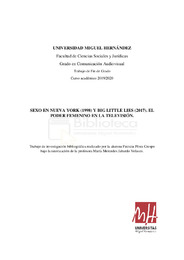Por favor, use este identificador para citar o enlazar este ítem:
https://hdl.handle.net/11000/25643Registro completo de metadatos
| Campo DC | Valor | Lengua/Idioma |
|---|---|---|
| dc.contributor.advisor | Jabardo Velasco, María Mercedes | - |
| dc.contributor.author | Pérez Crespo, Patricia | - |
| dc.contributor.other | Departamentos de la UMH::Ciencias Sociales y Humanas | es_ES |
| dc.date.accessioned | 2022-01-07T13:51:13Z | - |
| dc.date.available | 2022-01-07T13:51:13Z | - |
| dc.date.created | 2020-09-01 | - |
| dc.date.issued | 2020-09-01 | - |
| dc.identifier.uri | http://hdl.handle.net/11000/25643 | - |
| dc.description.abstract | El consumo de las series ha aumentado potencialmente en las últimas décadas, así, la televisión se ha convertido en uno de los medios más influyentes de la actualidad. Junto con ello, también se han incrementado las mujeres protagonistas dentro de estas series. Lo que no sabemos es si estas mujeres están representando una variedad real o, por lo contrario, nos están mostrando unos roles estereotipados. Es por eso que hemos cogido dos series, de dos épocas diferentes, aclamadas por la crítica feminista: Sexo en Nueva York (1998) y Big Little Lies (2017), para, de esta manera, poder comprobar si, en la primera se seguían unos estereotipos y, en la segunda, se siguen repitiendo, o por el contrario algo ha cambiado | es_ES |
| dc.description.abstract | The consumption of series has potentially increased in recent decades, in the same way, nowadays television has become one of the most influential media. Along with this, the female protagonists in series have also increased. What we do not know is if these women are representing a real variety or, by contrast, they are showing us stereotypical roles. That is why we have chosen two series, from two different periods, acclaimed by feminist critics: Sex and the city (1998) and Big Little Lies (2017) so, we can be able to check if, on the first one, they followed stereotypes to create their characters and, on the second one, if we are still watching the same type of roles on the female main characters or instead something has changed | es_ES |
| dc.format | application/pdf | es_ES |
| dc.format.extent | 25 | es_ES |
| dc.language.iso | spa | es_ES |
| dc.publisher | Universidad Miguel Hernández de Elche | es_ES |
| dc.rights | info:eu-repo/semantics/openAccess | es_ES |
| dc.rights | Attribution-NonCommercial-NoDerivatives 4.0 Internacional | * |
| dc.rights.uri | http://creativecommons.org/licenses/by-nc-nd/4.0/ | * |
| dc.subject | medios de comunicación | es_ES |
| dc.subject | estereotipos | es_ES |
| dc.subject | mito de la belleza | es_ES |
| dc.subject | personajes femeninos | es_ES |
| dc.subject | Sexo en Nueva York | es_ES |
| dc.subject | Big Little Lies | es_ES |
| dc.subject | mass media | es_ES |
| dc.subject | stereotypes | es_ES |
| dc.subject | the beauty myth | es_ES |
| dc.subject | female characters | es_ES |
| dc.subject | sex and the city | es_ES |
| dc.subject.other | CDU::3 - Ciencias sociales::31 - Demografía. Sociología. Estadística::316 - Sociología. Comunicación | es_ES |
| dc.title | Sexo en Nueva York (1998) y Big Little Lies (2017). El poder femenino en la televisión | es_ES |
| dc.type | info:eu-repo/semantics/bachelorThesis | es_ES |

Ver/Abrir:
TFG-Pérez Crespo, Patricia.pdf
527,95 kB
Adobe PDF
Compartir:
 La licencia se describe como: Atribución-NonComercial-NoDerivada 4.0 Internacional.
La licencia se describe como: Atribución-NonComercial-NoDerivada 4.0 Internacional.
.png)